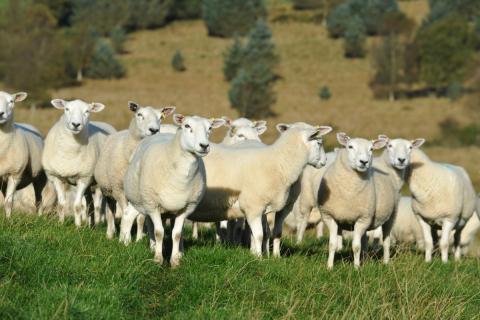A Welsh upland farm is saving £4/ewe off its pre-lambing feed costs by switching to a Total Mixed Ration (TMR) system that incorporates a treated soya product with high quality silage.
Keith Williams runs 885 Lleyn and Texel-cross ewes at Hendy, a 400-acre upland farm at Hundred House, near Llandrindod Wells.
Mr Williams had traditionally fed twin and triplet bearing ewes concentrates up to twice a day, starting from 8 weeks pre-lambing, but wanted to reduce the cost and labour input associated with this.
He has achieved both with a TMR that combines a source of protected protein high in Digestible Undegradable Protein (DUP) and clamp silage with a minimum ME of 10.5 that meets the energy and protein needs of ewes in late pregnancy.
The new feeding system, which Mr Williams first trialed through his work as a Farming Connect Focus Site, cost £1.36/ewe in the 2017 lambing period compared to £5.50/ewe when the flock was fed concentrates.
Mr Williams calculates that this has resulted in an overall cost saving of approximately £4,190.
“It’s a huge amount and has benefits that go way beyond the actual cost saving on feed,’’ he says.
During the winter of 2016/17, ewes were outwintered on a forage crop before they were housed 30 days before lambing; at this point they were introduced to the new ration with 50g of the protected protein allocated per foetus carried.
The new system incurred an initial outlay of £4,750 in a new mixer wagon but, based on the cost savings, Mr Williams says the machine will pay for itself within two years.
He had been feeding 23 tonnes of concentrates but wanted to reduce his costs to maximise output per ewe.
By changing the feeding system, he says he has not only made savings on feed but flock health has improved too.
When ewes were fed concentrates – up to 1.5kg/head/day just before lambing – there were some issues with acidosis and twin lamb disease.
Using a balanced TMR ration has reduced cases, says Dr Catherine Nakielny, Red Meat Technical Officer at Farming Connect, who oversaw the trial.
“It means that high levels of starch are not being fed and helps to avoid the metabolic upsets that feeding high levels of compounds can sometimes lead to,’’ she says.
Prolapses, which can be due to feeding high levels of concentrates have decreased in number too, Dr Nakielny reports.
Ewes being fed the TMR diet also seemed more content and rested for longer periods, she adds. “Keith has observed that 20% of ewes didn’t push forward when fresh feed was added.’’
The system, Dr Nakielny stressed, does rely on high quality silage. The beneficial effects of protected soya protein can only be fully realised if silage has a minimum ME of 10.5.
Feeding a silage with lower ME levels than this means that extra energy is needed in the diet.
“In some cases straight soya can be fed in the ration or alternatively other higher energy feeds can be added to the diet to help ensure a balance of energy and protein in the crucial run up to lambing,’’ Dr Nakielny advises.
Analysis of the 2016 cut clamp silage at Hendy indicated that it had an ME of 10.9% with a dry matter of 34% and crude protein levels of 14.4%.
Dr Nakielny says it is important not to overlook other nutritional requirements. “At Hendy, ewes are supplemented with vitamin and mineral supplements to match the silage analysis,’’ she says.
The ewe’s body condition score must also be assessed in the run up to lambing and action taken if needed.
Labour savings
Mr Williams calculates that the new system has saved him around 51 hours in labour over the lambing period.
He doesn’t employ any staff apart from a lambing student for two weeks during the lambing period.
Ewes were previously fed up to twice a day for 56 days but that has been reduced to 30 days, once a day.
“It now only takes me up to 10 minutes a day to feed which means I have more time to get other work done,’’ says Mr Williams.
What is protected protein soya?
This product has been used elsewhere in the farming industry, particularly in the dairy sector, but it is not commonly used in sheep systems.
It contains a high level of Digestible Undegradable Protein (DUP), making it a highly palatable feed that can be fed on its own or used in a variety of diets.
It offers farmers big savings on time, cost and labour over conventional approaches in which Rumen Degradable Protein (RDP) can be overfed, says Dr Nakielny.
Top tips for feeding TMR in combination with protected soya protein
Ensure there is adequate feed space
Ewes must be in good body condition
Good quality palatable silage is vital and this should be tested in appropriate batches
The system is easiest if ewes are fed indoors pre-lambing so it may not be feasible for outdoor regimes
Hendy – farm facts
Ewes mated with Lleyn and Texel rams
Lamb supplied to Waitrose
Small flock of Texels, performance recorded for growth rates and muscle depth
The entire farm, of which 380 acres are owned, is in the Glastir agri-environmental scheme
Closed herd of 20 pedigree Welsh Black cattle

